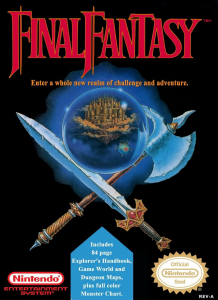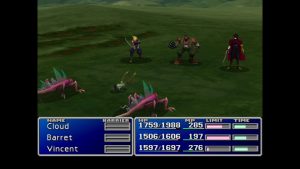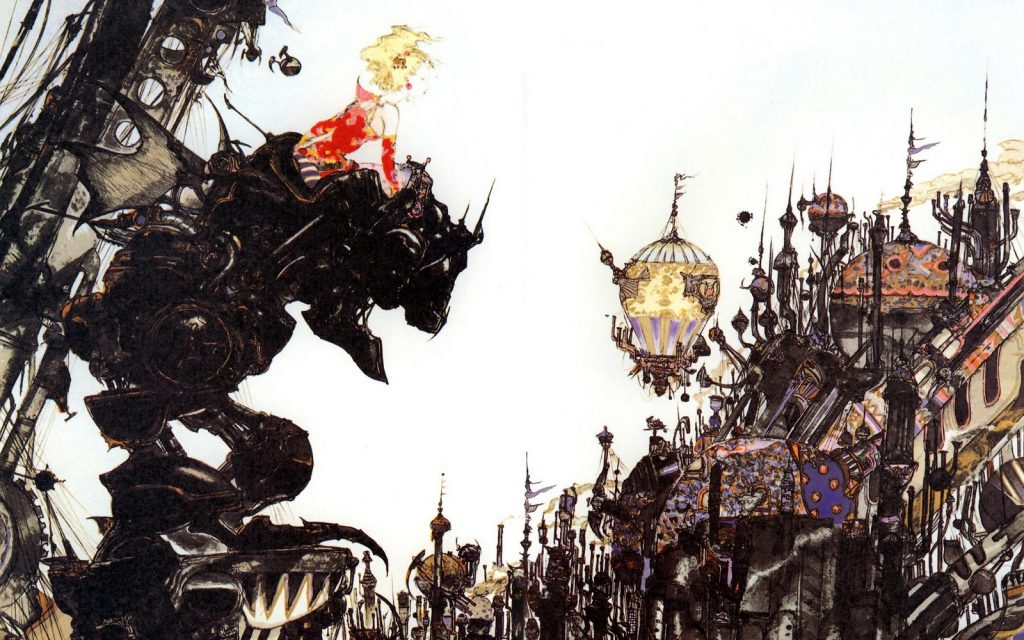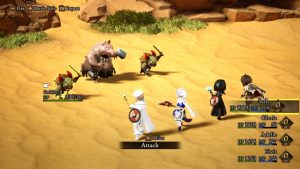I first learned about Final Fantasy in Nintendo Power magazine around 1990. In a multi-page spread, Nintendo announced the Summer of Final Fantasy with great excitement. The fan mag promised us dozens of hours of story and exploration with a customizable party in a massive new world. When the game released, I spent countless hours with my friends playing through the title, trying different combinations of party and equipment to bring light back to the world and defeat the plans of the evil Chaos. Now, thirty years later, the 16th entry to the series has been announced, and as an aging gamer who has been a fan of the series for 30 years, looking back, I wonder what it means now and whether it’s left its oldest fans behind.

The original Final Fantasy arrived in North America in 1990
The definition of a Final Fantasy game has always been somewhat nebulous. By design, the biggest constant in the series has been change. While all the main numbered series of games are RPGs, they’ve had turn-based battles, semi-real time battles, action battles and have consisted of single player games and massively multi-player online extravaganzas. When you take the spin-offs into account, the series includes racing games, fighting games, and rhythm games.
And yet, there are still the familiar elements that creep into almost every game: crystal MacGuffins, the presence of Chocobos — giant Ostrich-like birds that do the work of horses — the use of a semi-regular stable of summoned monsters, and a few familiar pieces of music that evoke instant familiarity and nostalgia. While these elements take a greater or lesser emphasis between games, occasionally disappearing altogether, they are still near-constants that give a work an instant Final Fantasy feel.
There are also certain aesthetic sensibilities at play throughout the series. The majority of the artwork in the franchise has sprung from three different artists who all have distinctive styles: Yoshitaka Amano, Tetsuya Nomura, and Akihiko Yoshida. While fans argue about whose art is better or worse, there is a clear set of visual principles that make an instantly recognizable Final Fantasy look, which is as distinct an aesthetic as one will find in popular speculative fiction franchises like Star Wars and Dune. There is an almost indescribable “Final Fantasy-feel” that fans know when they see it.
While the constant in the Final Fantasy series has been change, there have been numerous points in its history where the fan-base split over some of the more pronounced changes. The first major schism came with the launch of Final Fantasy VII. While previous games took place in traditional Western fantasy-type settings, Final Fantasy VII took a more futuristic, cyberpunk aesthetic. It also was the first game in the series to launch on the Sony PlayStation rather than a Nintendo console. While these changes seem small in retrospect, they were enormous at the time and caused the first of many new school/old school splits. With each succeeding entry, the series created new controversy, from Final Fantasy VIII’s abandonment of traditional magic systems to Final Fantasy X dropping the Active Time Battle System that was used in the previous six games. But the two biggest changes were to happen with the next two entries.

Final Fantasy VII launched the series into the mainstream with its state of the art visuals and memorable story
Final Fantasy X-2 was the first direct sequel in the series. The first nine games were all created as standalone works with each title introducing a new world, story, and characters. The continuation of Final Fantasy X’s story was a stunning development, especially given Final Fantasy X’s incredibly dramatic finale. Many fans felt that a sequel betrayed the themes of the game and the series’s traditions. Others wanted to spend more time in Final Fantasy X’s world of Spira and to undo the previous game’s tragic finale. The fact that Final Fantasy X-2 was bright, cheerful, and campy in contrast to Final Fantasy X’s tragic, wistful tone didn’t help.
Final Fantasy XI was an even bigger change: a massively multiplayer online game. While it was well-received by those who played it and maintains an active subscribing player base to this day, many people refused to even recognize it as a numbered Final Fantasy title due to its not being a single-player game like the previous ten plus entries.
Final Fantasy XII was met with mixed reviews. Final Fantasy XIII was even more divisive, with many claiming it was the worst game in the series. Final Fantasy XIV was yet another MMO and Final Fantasy XV was an action RPG. To say the series was developing an identity crisis is an understatement.
Today, saying you’re a Final Fantasy fan will inevitably lead to conversations about what kind of fan you are. Are you an old school fan? Do you like the new entries? Do you like the MMOs? The series continues to sell well with the latest entry, Final Fantasy VII Remake, lighting up the sales charts despite only being released on the PlayStation 4. But the fact that is a remake of the most popular game in the series, a title that’s 23 years old at the time of this writing, shows how difficult a time Square Enix has pleasing their large and diverse fan-base. Final Fantasy VII Remake itself has something of a split personality, managing to somehow combine action-based combat with the older Active Time Battle System menu commands. The fact that such a bizarre blending works is astonishing and a sign that there are still plenty of talented and creative people at Square Enix. But despite Final Fantasy VII Remake’s success, the fan schisms remain.

The ethereal art of Yoshitaka Amano has been a staple since the first entry of the series. This concept art comes from Final Fantasy VI, one of the series’ best loved entries.
This leads to the announcement of Final Fantasy XVI on September 16, 2020 during the PlayStation 5 Reveal event. Once again, the game appeared to be an action RPG, this time set in an extremely grimy, medieval European style setting. Series staples like Chocobos, summoned monsters, and crystals were all present. And when I checked my social media feeds my friends were completely divided. Some were excited for the game as the first entry in a long time that actually made them care about the series. Others complained that it looked too much like Dark Souls and Witcher 3, and they wanted it to be more extravagant and incorporate more of the outrageous settings Final Fantasy had been known for. Still others, myself included, were disappointed, but not surprised, that the series continued to focus on action instead of a more strategic, laid-back, turn-based battle system.
Perhaps the biggest schism in the series happened behind the scenes. Hironobu Sakaguchi, the creator of the series, left Square Enix under a cloud after his film Final Fantasy: The Spirits Within flopped hard at the box office. He went ahead to create his own game studio called Mist Walker and produced a trio of cult classic RPGs: Blue Dragon, Lost Odyssey, and The Last Story. All three titles met with some acclaim and decent sales, but none could reach the sales highs of the series he created. Despite this, some referred to Lost Odyssey as the “real Final Fantasy XIII” because of Sakaguchi’s involvement, along with long-time series composer Nobuo Uematsu. This view grew more pronounced when Final Fantasy XIII launched to a less than stellar reception.
Sakaguchi directed the first five games of the series and was a leading creative voice up until he left the company. He famously loathed sequels, wanting each entry to be a new journey and a new story. Final Fantasy X-2 was one of the first games released after his departure. This was followed by the poorly received Final Fantasy IV: The After Years, the mixed reception of the “Compilation of Final Fantasy VII” a set of games and a movie set both before and after Final Fantasy VII. Final Fantasy XII received a Real-Time strategy spin-off called Revenant Wings. The gaps between main numbered releases seemed to get longer and longer while the brand-sullying spin-offs were pumped out at an alarming rate. While Final Fantasy titles were often divisive under Sakaguchi’s management, they were consistently critically acclaimed. In his absence, critical reception for the series declined.

The Bravely Default games look and play like old school Final Fantasy games, but aren’t technically part of the series.
A few years ago, Square Enix began launching lower budget titles that more closely resembled older style Final Fantasy games with turn-based battles and the popular job system featured in games like Final Fantasy III, Final Fantasy V and Final Fantasy Tactics. The first of these, Bravely Default, became an unexpected hit when it was released in the West. A sequel, Bravely Second, was quickly released. Many of the same developers were then brought on to create a similar old school, turn-based RPG called Octopath Traveler, which wound up the top selling game in North America during its month of release in July of 2018 according to the NPD group. Bravely Default II is expected to release in 2020.
Despite these successes, the core Final Fantasy series seems to be attempting to reach a larger audience by embracing action gameplay. Bravely Default notably lacked the Final Fantasy branding despite arguably looking and playing more like a traditional Final Fantasy game than the concurrently released, more action-based, and wildly experimental Lightning Returns: Final Fantasy XIII. This two-tiered dynamic makes me wonder what the Final Fantasy branding means anymore. If a game that looks and plays like a Final Fantasy game like Bravely Default isn’t a Final Fantasy and an action game like Final Fantasy XV is, what does it mean to be Final Fantasy in 2020? Why do I still care about the brand and want it to succeed? Is it habit? Nostalgia? It’s not because I have a deep love of summoned monsters and Chocobos or even Nobuo Uemtasu’s harp arpeggios.

The Final Fantasy VII Remake, released this year, tries to split the difference between real-time action and menu-based combat. Reviews have been largely positive.
Why am I still part of the Final Fantasy community despite becoming cynical and detached from the series itself? It is surprisingly simple. I am part of the Final Fantasy community because it is a community. It’s a pillar upon which I’ve built relationships, and those relationships have lasted despite the series’ ups and downs. I met my wife and many of my best friends on a Final Fantasy message board. I’ve connected with many people on twitter simply through love for the series, whichever parts. Together we cheer or groan over each new entry as its announced, go to concerts, write fan fiction, buy assorted fan paraphernalia, and come up with bizarre theories about the deeper backstories of each game. While I mourn for what I consider the series heyday, I still actively play Final Fantasy XIV, and am still willing to give Final Fantasy XVI a go simply because my friends will too and it’s something we can share and argue over. I’ve found the Final Fantasy community to be less prone to gatekeeping. I don’t feel like the series fandom is dominated by a dudebro elite, looking to keep people out. Its fans come from all races, nationalities and genders. It’s not a perfect community as all the generational conflict will attest, but because the series keeps changing and because the older entries stay available, there’s always something new or old to talk about and there’s always new art, musical arrangements, toys, and clothing being produced by its fans. It’s the community that I can’t and won’t leave behind, even if the games become terrible and Square Enix closes its doors.

My first ff game was 8, so that really set the tone of the series for me. 8, 12, and 14 are my favourites. I hated 13 and 15, and I’m kind of disappointed in the gritty realism look of 16. I’ll probably still play it? Depending on console availability, but I’m not pumped for it. 14 is one of my favourite games – it’s everything I love, really, but I don’t have time for an mmo in my life.
Great write up! Good background info and opinions, and a great question. What does it even mean to be a fan of a game that is so different in each iteration. I would argue that the span of the story is also a ff hallmark. It should be epic, spanning across the whole world eventually, and have consequences for the world if the team fail. Often there are challenges to gods or supreme beings. I think 10-2 breaks that particular guideline? But I still think it’s a good indication of a ff game – even of an RPG in general.